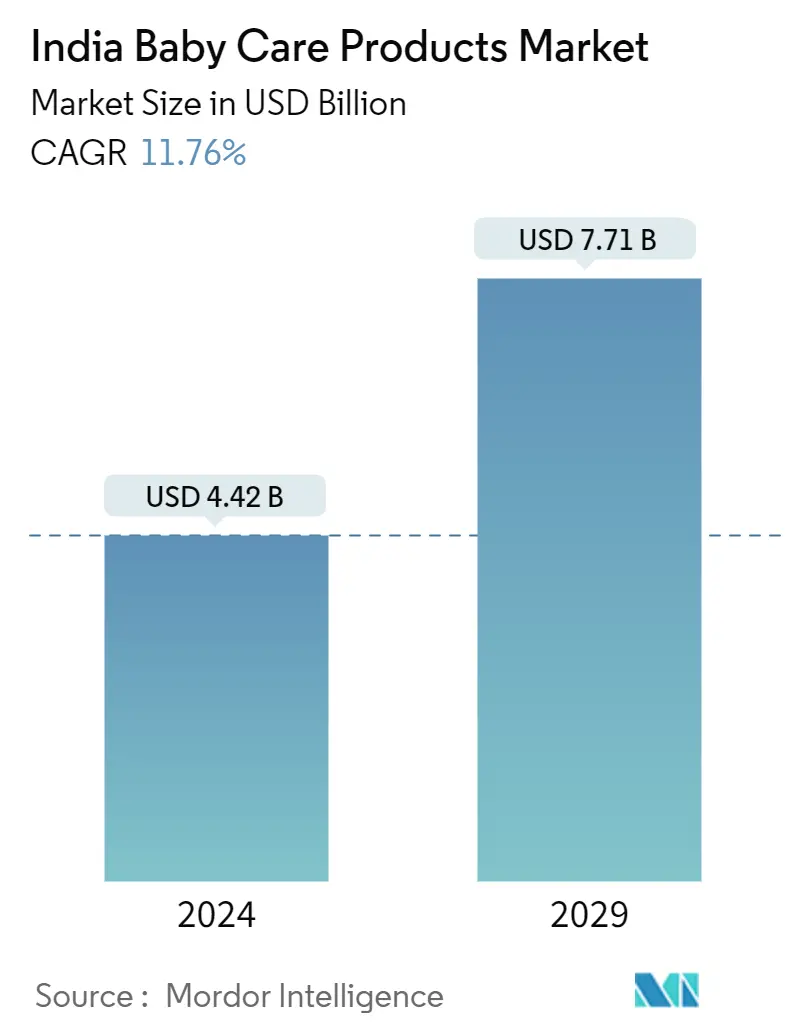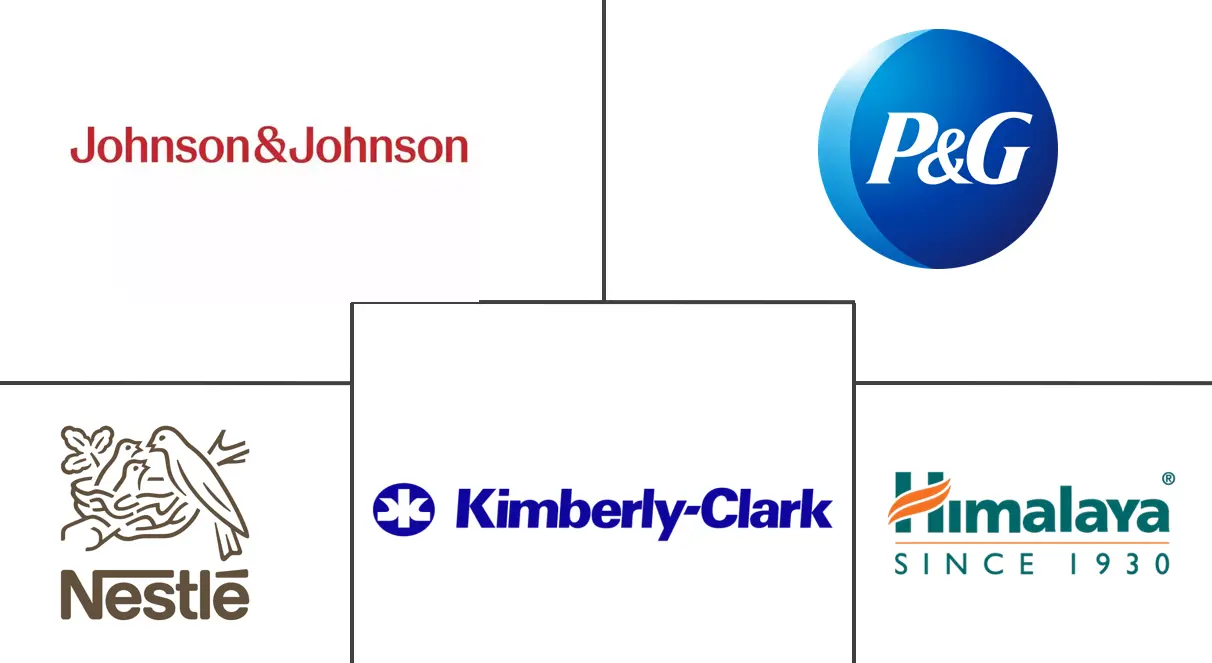Market Size of India Baby Care Products Industry

| Study Period | 2019-2029 |
| Base Year For Estimation | 2023 |
| Market Size (2024) | USD 4.42 Billion |
| Market Size (2029) | USD 7.71 Billion |
| CAGR (2024 - 2029) | 11.76 % |
| Market Concentration | Low |
Major Players
*Disclaimer: Major Players sorted in no particular order |
India Baby Care Products Market Analysis
The India Baby Care Products Market size is estimated at USD 4.42 billion in 2024, and is expected to reach USD 7.71 billion by 2029, growing at a CAGR of 11.76% during the forecast period (2024-2029).
- Baby care products are designed to cater to the unique needs of babies and young children whose delicate skin requires special care and attention. These products are formulated to be mild and gentle, with a focus on providing hydration and nourishment to the skin while keeping it clean and comfortable. The baby skincare products market in India has witnessed significant growth in recent years. The increasing awareness among parents regarding the importance of using safe and natural products for their babies' skin has led to a rise in demand for baby skincare products.
- Moreover, the growth of the e-commerce industry has made it easier for parents to access a wider range of products and purchase them online. The increasing number of women joining the workforce in India has led to a rise in demand for baby care products, as working parents have less time to follow traditional methods of infant care.
- Additionally, the use of innovative product packaging and the incorporation of organic ingredients with health benefits has further boosted the demand for baby care products in India. These trends are expected to continue driving the growth of the baby care products market in India in the coming years.
- The trend towards organic and herbal products is not limited to adults but is also becoming increasingly popular among parents when it comes to their babies. This shift towards natural and organic baby products is driven by a growing awareness of the potential health benefits of using such products. Overall, the trend towards organic and herbal baby products will likely continue as more and more parents become aware of the potential benefits of using such products for their babies. This presents an opportunity for manufacturers to develop and market high-quality, organic baby products to meet the growing demand.
- Furthermore, the growing health-conscious parent population significantly increases the demand for organic and fortified baby food. As a result, manufacturers are introducing new products in the market. For instance, in December 2022, Children's food brand Timios launched an organic porridge range for infants and toddlers. As per the company's statement, the porridge is made-to-order, which means they are freshly made upon receiving orders from the customers, eliminating the need for preservatives, and is made of only organic ingredients.
India Baby Care Products Industry Segmentation
Baby care products can be defined as products intended to be utilized on infants or children.
India's baby care products market is segmented by type and distribution channel. By type, it is segmented into baby skin care, baby hair care, baby toiletries, and baby food and beverages. By distribution channel, the market studied is segmented into hypermarkets/supermarkets, pharmacies/drug stores, convenience stores, online retailing, and other distribution channels.
The market sizing has been done in value terms in USD for all the abovementioned segments.
| By Type | ||||
| Baby Skin Care | ||||
| Baby Hair Care | ||||
| ||||
| Baby Food and Beverages |
| By Distribution Channel | |
| Supermarkets/Hypermarkets | |
| Convenience Stores | |
| Pharmacies/Drug Stores | |
| Online Retailing | |
| Other Distribution Channels |
India Baby Care Products Market Size Summary
The Indian baby care products market is experiencing robust growth, driven by increasing awareness among parents about the importance of using safe and natural products for their babies. This market is characterized by a rising demand for baby skincare products that are mild, gentle, and formulated to provide hydration and nourishment to delicate baby skin. The growth of the e-commerce industry has further facilitated access to a broader range of products, making it easier for parents to purchase these items online. Additionally, the increasing number of working women in India has contributed to the demand for baby care products, as they seek convenient solutions that fit their busy lifestyles. The trend towards organic and herbal products is gaining momentum, with parents increasingly opting for natural ingredients due to their perceived health benefits. This shift presents a significant opportunity for manufacturers to develop and market high-quality organic baby products.
The competitive landscape of the Indian baby care products market is marked by the presence of both regional and global players, such as Johnson & Johnson, Nestlé, Procter & Gamble, and Himalaya Global Holdings. These companies are focusing on product innovation and quality enhancement to maintain a competitive edge. The market is also witnessing the introduction of new products, such as organic baby food and skincare items, catering to the growing demand for clean-label and natural products. The increasing internet penetration is expanding the consumer base, including rural areas, which is further propelling market growth. As manufacturers continue to leverage advanced distribution networks and manufacturing expertise, the market is expected to see continued expansion, driven by the rising interest in herbal and natural baby care solutions.
India Baby Care Products Market Size - Table of Contents
-
1. MARKET DYNAMICS
-
1.1 Market Drivers
-
1.1.1 Increasing Demand for Organic Baby Care Products
-
1.1.2 Increasing Demand for Herbal Baby Skincare Products
-
-
1.2 Market Restraints
-
1.2.1 Availability of Counterfeit Products
-
-
1.3 Porter's Five Forces Analysis
-
1.3.1 Threat of New Entrants
-
1.3.2 Bargaining Power of Buyers/Consumers
-
1.3.3 Bargaining Power of Suppliers
-
1.3.4 Threat of Substitute Products
-
1.3.5 Intensity of Competitive Rivalry
-
-
-
2. MARKET SEGMENTATION
-
2.1 By Type
-
2.1.1 Baby Skin Care
-
2.1.2 Baby Hair Care
-
2.1.3 Baby Toiletries
-
2.1.3.1 Baby Bath Products and Fragrances
-
2.1.3.2 Baby Diapers and wipes
-
-
2.1.4 Baby Food and Beverages
-
-
2.2 By Distribution Channel
-
2.2.1 Supermarkets/Hypermarkets
-
2.2.2 Convenience Stores
-
2.2.3 Pharmacies/Drug Stores
-
2.2.4 Online Retailing
-
2.2.5 Other Distribution Channels
-
-
India Baby Care Products Market Size FAQs
How big is the India Baby Care Products Market?
The India Baby Care Products Market size is expected to reach USD 4.42 billion in 2024 and grow at a CAGR of 11.76% to reach USD 7.71 billion by 2029.
What is the current India Baby Care Products Market size?
In 2024, the India Baby Care Products Market size is expected to reach USD 4.42 billion.

